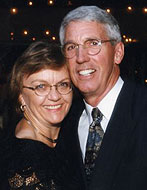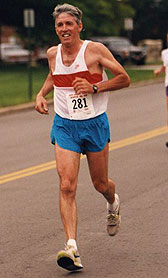
"My Husband Didn't Have to Die"
One day my husband, Jim, was active, athletic and enjoying life. The next day he
was gone. His death from complications of deep-vein thrombosis (DVT) was a terrible
shock to me, and six years have done little to ease the pain. The worst part is
knowing that it didn't have to happen – that if anyone had warned us that Jim was
at risk for DVT and told us how we could avoid it, he might still be here today.
Joining the campaign
I have since learned that that's the nature of DVT. It can sneak up and take you,
and you're gone. When I heard the news of David Bloom's death in 2003, it felt like
another devastating loss. In the two years since Jim had died, I had done a lot
of reading about DVT and knew how it happened. But I still was shocked that it had
taken yet another life, for no good reason. Why didn't somebody tell David he was
at risk? For that matter, why wasn't somebody telling everybody about DVT?
Soon after, I saw Melanie Bloom on Larry King Live and realized that somebody was
doing just that. I wanted to help in any way I could. When I went to the Coalition
to Prevent DVT Web site, I saw "Share your story" and typed in the story of Jim's
and my experience with DVT. If telling our story makes just one person more aware
of the symptoms of this condition, I'll be grateful.

Healthy and fit
Jim had retired in 1995 and become the best "househusband" I could wish for, keeping
things running smoothly at home while I continued working as an insurance agent.
In early 2001, when he had elective knee surgery, he was a youthful 60 year old.
At 6'5" and 220 pounds, he was in excellent physical condition. He didn't smoke,
took good care of himself and loved to run. In fact, that was why he decided to
have the surgery – he said he wanted to run at least one more marathon before he
got old.
The surgery, performed on February 15, was successful and caused no apparent complications.
Afterward, the doctors didn't mention any heightened risk of developing blood clots;
they didn't prescribe blood thinners or even tell Jim to take aspirin. They did
provide a passive-exercise device for him to keep his legs moving while he recuperated
in bed, but after four weeks they said he didn't need it anymore, so he stopped
using it.
DVT strikes

On March 27, we called the doctor because Jim's leg was swollen. My husband said
he wasn't in pain, and maybe he was telling the truth – "pain" is a relative term.
But I think he was just too stoic to admit he was suffering. The doctor simply told
him to elevate the leg and place ice packs on it. When I arrived home that evening
the swelling was not nearly as bad.
Jim accompanied me to a business meeting that evening about wills and estate planning.
When the meeting ended after about an hour and a half, we walked to the car, Jim
on his crutches. Then, after we got in the car, he passed out. I drove straight
to the hospital, where right up to the emergency room door he protested that he
was fine and wanted to turn around and go home.
In the emergency room, as Jim was talking to the doctors, he got sick to his stomach.
The doctors went to put him on the table to examine him. As they lifted him, his
entire body suddenly went completely limp and turned purple from the neck down.
In a matter of seconds, my husband was gone. He never knew what had hit him – a
pulmonary embolism.
Beating my drum
The loss of my vibrant husband to DVT has changed me in many ways, especially the
way I now live my life. Although my life will never be the same, I am now empowered
to be more proactive about the health care of everyone I love, asking more questions
and doing my own research. I've learned the hard way that not all health care professionals
are as aware of DVT as they could be, and even those who do know the facts may not
communicate them to their patients.
When I meet anybody who is scheduled for surgery, I tell them to read up on DVT.
It would be wonderful if a year from now, everyone scheduled for any kind of surgery
was handed a pamphlet about DVT and had a health care professional go over it with
them. Until these actions become standard operating procedure, it's up to people
like you and me to fill the knowledge gap. We need to spread the word to everyone
at high risk for DVT: not only hospital patients, but also everyone who travels
by air, pregnant women on bed rest, and people that work in offices and call centers,
who sit for hours at a time.
The good news about DVT is that it's preventable and treatable. It's just a matter
of making everyone aware of it. I know I'm going to keep beating this drum until
everybody hears it!